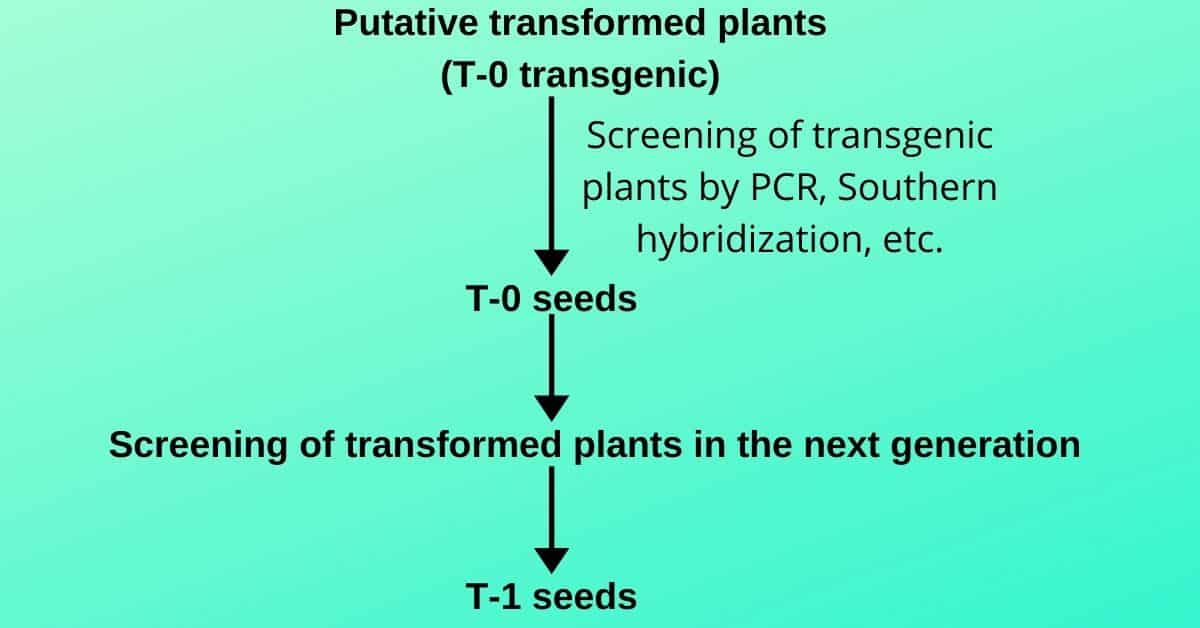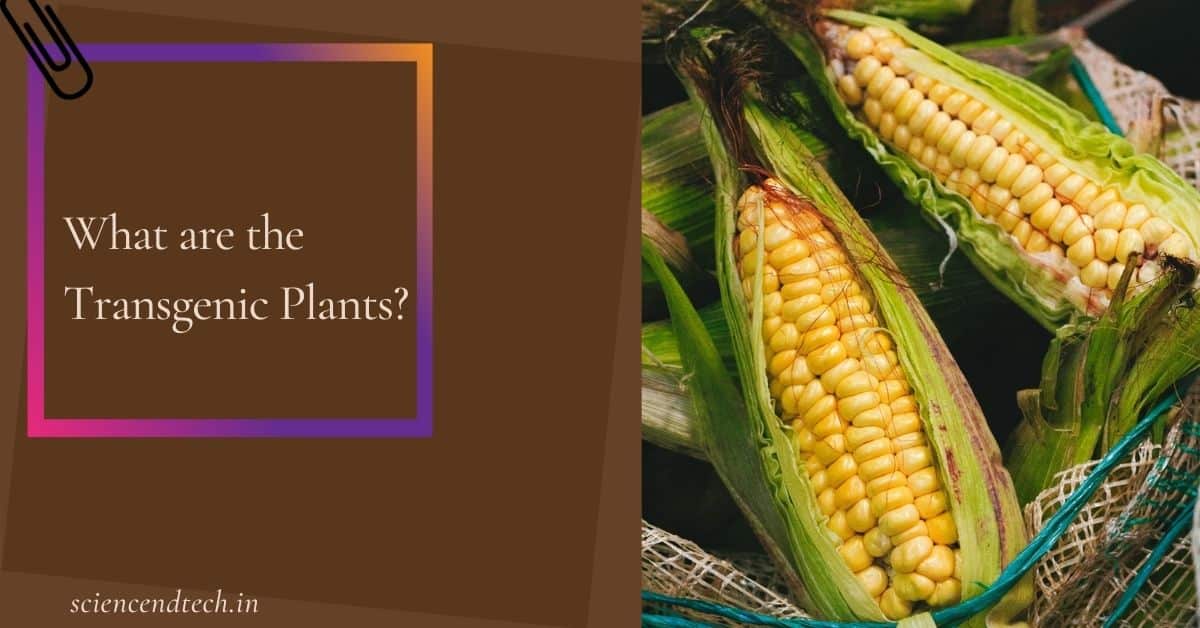The term Transgenic plants refer to those plants which are developed by modern genetic engineering processes. An integrated application of rDNA technology, gene transfer methods and tissue culture techniques have been made in the development of transgenic plants.
This means that more than one gene is introduced and combined with the genetic material of the plant, as a result, traits of the original genome are changed.
The first transgenic plants were produced in 1982.
Development Of Transgenic Plants
The application of the recombinant technique for the horizontal transfer of genes in the plant system has several limitations. A huge amount of DNA in the plant genome, which can accommodate sequences equivalent to 6-7 million genes in an average crop plant. Several genes are located outside the nucleus, namely the chloroplasts and mitochondria. For instance, the nitrogen-fixing gene of bacteria- Rhizobium has 17 genes of 24 kilobases, distributed under eight operational units or operations. These units along with their promoter and terminator require to be identified and isolated. The absence of a large number of vectors is another problem, which would carry the desired gene to the recipient. In this process, the common vector is the Ti plasmid of Agrobacterium.


Despite the above limitations, progress achieved so far with the existing technology. In almost all major crops, for crop improvement, some of the agronomic traits could be introduced by a transgenic approach where the genetic variability has been utilized from other gene pools. Here, some of the traits improved through the transgenic approach are being discussed.
application of transgenic plants
Resistance against the biotic stresses
In such types of plants like tobacco, cotton etc. the use of transgenics with toxin genes of Bacillus thuringiensis (bt gene) is a successful application. especially in tobacco and cotton. Successful results are also obtained, by using proteinases against insects, digesting the insect protein, and chitinases against fungi like Rhizoctonia solani. And also get after utilizing endogenous antibodies, effective against infection by pathogen- viral, bacterial or fungal.
Resistance against abiotic stresses
Firstly identified the total number of genes that are responsible for providing resistance against various types of biotic and abiotic stresses. A gene for the production of glycerol-I-phosphate acyltransferase has been isolated from Arabidopsis and transferred to tobacco which imparts resistance against chilling.
Herbicide resistance
Herbicide inhibits plant growth by blocking the biosynthesis of essential amino acids, such as glyphosate which inhibits the synthesis of aromatic amino acids. A resistance gene from Salmonella typhimurium is isolated and introduced for developing glyphosate-resistant tobacco and wheat plants.
Improvement of vitamin content
To save a large population of children from vitamin A deficiency, the improved variety of transgenic rice has been developed with a 23 fold increase in food grain quality and quantity of production.
Improvement in nutritional equality
The protein content is being altered through a change in amino acid content like an increase in lysine content, etc. In the case of oilseed crops, the change in content and composition of fatty acids have been attempted through transgenic plant production.
Production of edible vaccines
The gene for vaccine production has been introduced in some fruits which can be helpful for the eradication of some of the diseases. And those will be very useful products for daily use.
Development of seedless fruit
A transgenic approach has been taken to develop fruit without pollination (Parthenocarpy), leading to seedless fruit development and high solidity in fruit pulp which helps in the food processing industry.
Molecular farming
Transgenic plants are also proposed to be used as factories or bioreactors for specially chemicals and pharmaceuticals. Sugars, fatty acids, starch, cellulose, rubber and wax are obtained from plants, transgenics are made to get more production.
In transgenic plants, Araidopsis, pHB ( polyhydroxy butyrate ), a biodegradable polymer can be produced through this biotechnological mechanism.
Improved agricultural traits
Improvement in phosphorus uptake through the use of phosphorus transporter genes had been achieved to reduce dependence on fertilizer application. Improvement in harvest index I’d attempted using phytochrome genes.
Transgenic plants for other different traits
Other traits are improvement in architecture, colour, fragrance and bad life of flowers of commercial value, development of caffeine-free transgenic coffee, improvement of iron content in the crop like rice and any other crops which are used in human’s daily life etc.
Disadvantages
- Transgenic crops have been causing allergies in some people, Although it is uncertain whether transgenic crops are the source of the reaction.
- Transgenic crops cause damage to the natural environment. Ex- one type of bacterial toxin released from the pollen of hybrid corn.
- EPA – Environmental protection agency evaluates potential environmental impacts, especially for genes that produce pesticides.
- Sometimes the agronomic qualities are not as good as the other classical cultivars. In the case of these types of plants, resistance to herbicides, the appearance of resistant weeds that need to be eradicated with the classical harmful herbicides.
- If the climate changes and adapted seeds are obtained, the food of the future could be completely in private hands.
Should we use it?
Producers of Transgenic crops must have studied the advantages and disadvantages. And it also experiments on how effective results occur on human beings after using these types of crops. To determine the true safety of these plants and to decide whether they are safe for both the environment and living beings, more research is required. But we must agree that the potential advantage of producing these crops, which provide the human population with more and cheaper food, makes transgenic technology a useful invention.
In the present time, this modern biotechnological approach is implemented in so many dicot plants, such as herbs, shrubs, and trees and several monocots like maize, oat, rice, wheat.
transgenic plants as bioreactors
By introducing new formation in the form of new genes, it has become possible for researchers to take advantage of this process to produce various proteins including vaccines and antibodies among others.
Bacteria, lichen and many other types of cells have been used as bioreactors, now-a-days transgenic plants have been gaining more attention because they are less expensive and are capable of increasing agricultural traits.
That’s it for this post. If you have any query please feel free to comment below. Thank you.
What are the Transgenic Plants?
The term Transgenic plants refer to those plants which are developed by modern genetic engineering processes.
When did the first transgenic plants were produced?
The first transgenic plants were produced in 1982.
State one disadvantage of transgenic plants?
Transgenic crops cause damage to the natural environment. Ex- one type of bacterial toxin released from the pollen of hybrid corn.

